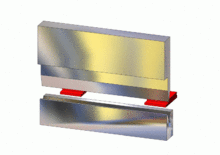Press brake
Sheet metal parts such as cladding parts, housings or machine components are produced by bending in a press brake , press brake or edging bench . The press basically consists of the bending punch and the bending die . If a tool storage and tool changing device are added, one speaks of a die bending center.
During die bending there is a sheet between the punch and the die. If the punch is now lowered, the sheet is pressed into the die and takes on the shape of the die. By not lowering it completely, any smaller bending angles can be created. In the case of more complex profiles , several countersinks are possible; after the first countersink, the sheet is positioned differently and the punch is lowered again. The press does not have to be set up again for this, which is why it is a very economical type of shaping.
Another machine that bends and folds sheet metal is the swivel bending machine .
safety
On press brakes built up to 2002, the operator's hands are protected by a two-hand safety circuit (ZHS) (according to DIN EN 574) with one or more control panels. The dangerous closing movement only takes place if the operator presses both switches on the desk at the same time. However, this type of sheet metal processing is no longer up-to-date for two reasons. Due to the high complexity of current sheet metal designs, most parts must be guided during bending. Furthermore, the ZHS method is very time-consuming and therefore also cost-intensive. This is one reason why older machines often deliberately bypass the two-hand control. Furthermore, the ZHS is bypassed in order to be able to hold the part. In order to avoid these problems, new machines have been equipped with accompanying safety devices as standard since 2002.
Holding arms are attached to both sides of the plunger, on which the safety system is installed on the underside. The system's sending and receiving units are attached so that the lower edge of the stamp is monitored. There are various monitoring concepts, but they all work optically.
The most common variant is the monitoring by means of one or more laser beams. Here, the interruption of the beam is detected as a trigger for an emergency stop of the machine. In order to have a box bend in these systems, i.e. H. To be able to perform a bend in which an already bent leg of the sheet metal comes into the safety area of the cameras, the operator must acknowledge this using the foot switch after the interruption of the laser beam has been recognized. Or the front laser beams are suppressed once for the box bending function.
New developments
While the development of the safety systems is very advanced, there is still some development need in the area of the holding arms. In order to also secure older machines (built before 2002) with an accompanying safety device, the holding arms must be adapted to the given conditions. Manufacturers of new machines do not face this problem, as they have every opportunity to integrate the holding arms during the machine's design phase. What both variants have in common, however, is that most poor people have no way of displaying the status of the safety system (active / inactive). This is necessary because many machine operators whose press has been equipped with an accompanying safety device work less carefully, as they assume complete protection during the bending. You are not aware that the system is inactive from the "Mute" point or, for example, when moving the back gauge. In order to counteract this misinformation, current developments in the retrofit area have recently offered an additional visual status display of the system via LED lights that are integrated into the holding arm.

